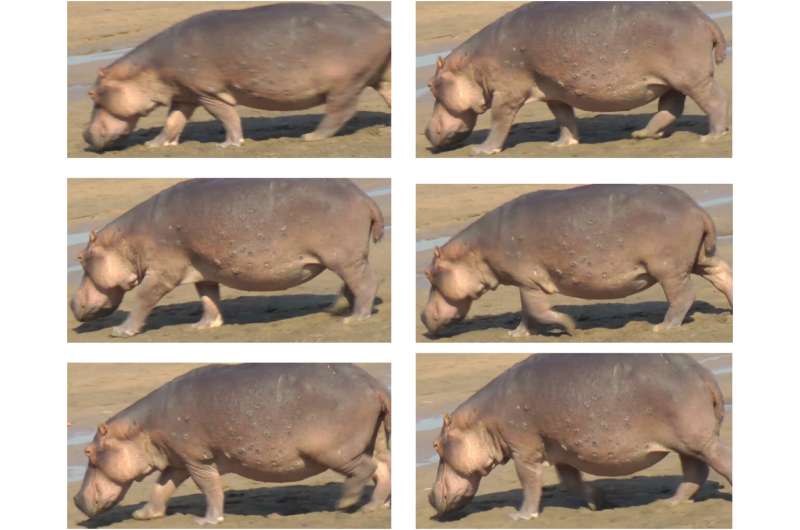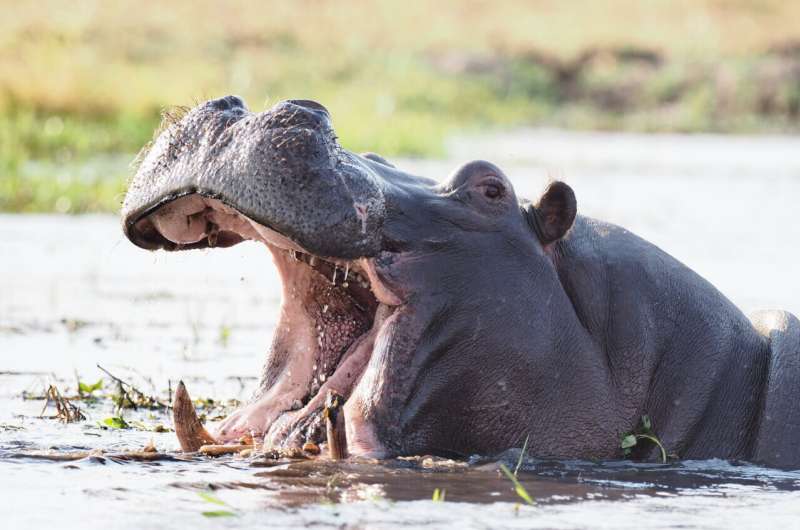Science
Related: About this forumHigh speed video shows hippos get airborne when running
JULY 5, 2024 REPORT
Editors' notes
by Bob Yirka , Phys.org

Footfall patterns and foot-on/foot-off definition examples for hippo locomotion data analysis. Images captured and cropped from internet video at:
A pair of evolutionary biomechanics specialists at the University of London's, Royal Veterinary College, has found that when hippos run at full speed, all four of their feet are regularly in the air.
In their paper published in the journal Peer J, John Hutchinson, and Emily Pringle, describe how they filmed hippos running at full speed using high speed cameras and what they found when they analyzed the results.
The hippopotamus has earned a reputation as being one of the most dangerous animals in the world to humans. They are known to attack when provoked and to give chase when the need arises. They are also very large, with males averaging 1,500 kg and females 1,300 kg. For such a large animal, they also run surprisingly fast—some have been clocked at speeds up to 30 km/hr.
In this new study, Hutchinson and Pringle wondered how such a heavy creature could reach such speeds, noting that little research has been done on the hippo gait because they are so dangerous to be around.
More:
https://phys.org/news/2024-07-high-video-hippos-airborne.html
~ ~ ~
JANUARY 24, 2022
Hippos recognize each other's voices, respond differently to calls of strangers
by Cell Press

Hippopotamus with its mouth open. Credit: Nicolas Mathevon
Hippopotamuses are rather vocal animals. Their "wheeze honk" calls can be heard over long distances, leading researchers to suspect the calls play an important role in maintaining social groups. Now, a study in the journal Current Biology on January 24 shows that hippos recognize each other's voices. They also respond less aggressively to the calls of a neighbor compared to those of a stranger.
"We found that the vocalizations of a stranger individual induced a stronger behavioral response than those produced by individuals from either the same or a neighboring group," says Nicolas Mathevon of University of Saint-Etienne, France. "In addition to showing that hippos are able to identify conspecifics based on vocal signatures, our study highlights that hippo groups are territorial entities that behave less aggressively toward their neighbors than toward strangers."
Mathevon and his colleagues are interested in bioacoustics, the study of how animals exchange information through sound. They're especially interested in communication networks, in which multiple individuals send and receive information all at once.
More:
https://phys.org/news/2022-01-hippos-voices-differently-strangers.html
StarryNite
(10,825 posts)It reminds me of the following:
How the first moving picture originated from a Stanford controversy
By Alexandra Blum
April 3, 2023, 10:08 p.m.
Cinema’s roots can be traced back to an obsession with man and machine … and Leland Stanford.
The first recorded moving picture, “The Horse in Motion,” is a sequence of images of a horse galloping. The images were shot with 12 staggered cameras, developed with a wet plate and a bath of silver nitrate and strung together into a film by a notorious technician.
snip~
The documentary sheds light on Muybridge’s perplexing relationship with Leland Stanford, founder of Stanford University. Leland Stanford wanted to win a bet that all four of a horse’s feet come off the ground at a fast trot. Determined to capture a horse in mid-air, he enlisted the help of Eadweard Muybridge in bringing the vision to life.
more at link:
https://stanforddaily.com/2023/04/03/how-the-first-moving-picture-originated-from-a-stanford-controversy/#:~:text=The%20first%20recorded%20moving%20picture,film%20by%20a%20notorious%20technician.